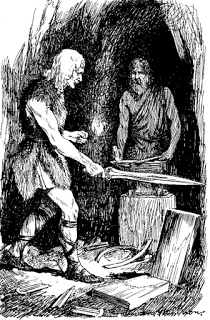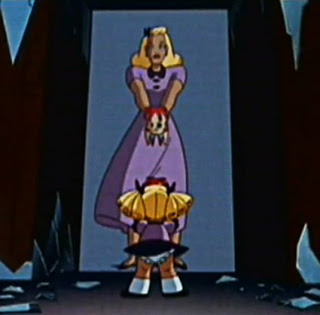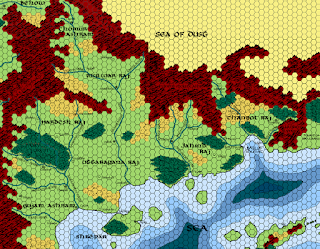I’m doing some research for my next 5E Greyhawk project, which is a treatment of Zindia, the India-analogue land south of the Sea of Dust, and I’ve come across something I think bears exploration. That is, many authors, when describing non-European cultures, tend to err on the side of faithfulness to the original material.
I submit this is contrary to the original game, and the subsequent versions of the rules based thereupon, which use historical and mythological material not as something to be utilized as-is, but rather to be used as broad inspiration, as if viewed through a warpéd mirror, in which the broad outlines are vaguely discernible, but the details become something new. We see this both in the implied setting of the rules, as well as in the published settings, particularly the World of Greyhawk.
A few examples might serve to illustrate my point.
The D&D (and AD&D) rules take in a lot of material from Biblical, Germanic, and Classical mythology, as well as more modern television sources (themselves a distorted version of those same sources in many cases) and produce something new. Take, for instance, the medusa. In Classical mythology, Medusa was a singular individual, one of the Gorgons. In D&D, a medusa is transformed into a whole race of creatures, and a gorgon is itself a completely different species (both of which share the common element of turning enemies to stone, however).
 |
| Regin (right) is a dwarf |
We see this in the player character races as well. Dwarves and elves come originally from Germanic mythology (Old Norse dvergar and alfar, among others), where they have a very different character than they do in the game. Of course, a lot of that comes from the influence of Tolkien (himself a noted scholar of Germanic myth and language), but he too was working with those original Germanic elements and turning them into something new.
Take, for instance, a D&D dwarf, who is a member of a mortal race, akin to humans but short in stature, who are skilled miners, stoneworkers, and metal-smiths. They have luxurious beards, and dwell in mountains or hills.
Now compare that to a dvergr from Norse mythology, where they are semi-divine creatures who are famed craftsmen, having created many of the gods’ magical weapons and treasures. They appear as normal men in stature and overall appearance, but the dwarf-names we have from the literary sources would seem to indicate a connection with death. Some believe they are a form of nature-spirit.
We would get the same sort of vague similarity of overall form, but startling differences in details, were we to perform the same exercise with elves, gnomes, kobolds, brownies, and on and on and on.
The same “warpéd mirror” is at play in the World of Greyhawk, which has rough analogies of many historical European lands and themes, but once again never quite slavishly true to the original. Thus Perrenland with its cantons is recognizable as fantasy-Switzerland; and the Ice, Snow, and Frost barbarians are the Viking-esque nations of the Norse, Danes, and Swedes; the Great Kingdom can be seen as the Holy Roman Empire; and of course the ever-present threat of the Baklunish is a sort of “cold war” version of the Medieval tension between Christendom and Islam, without either Crusades or Conquests. Not to mention the jumbling of timelines compared to history.
Religion is similarly only roughly analogous. Where in the real world monotheism arose to dominance in the late Classical period (and speaking of which, the fall of the Suel Imperium could be likened to the fall of Rome, with the Oeridian tribes as Germans, but fleeing the empire’s ruins instead of settling in them, in a wonderful reversal), no such impulse has overcome the Flanaess. The closest we see are the Henotheisms of Pholtus of the Blinding Light, St. Cuthbert of the Cudgel, and so forth.
In my research, however, I found a fascinating trend among those who have written “fantasy India” supplements or full RPGs over the last few years. Rather than using the historical India as a loose inspiration, and taking Hindu and Buddhist mythology as a source only in the loosest way, there seems to be a universal impulse to cleave very closely to the mythology as possible. There are, of course, exceptions, but the overall trend speaks to history rather than fantasy.
For instance, in Arrows of Indra and the Against the Dark Yogi Campaign Options book, Gandharvas are literally messengers of the gods, and the gods can pull them aside to deliver a message or perform some service. In the latter book, yakshi are tied to a particular patch of land which is sacred to them. There are similar examples in Sahasra and Tales from the Ganges, too. Some of those books have a setting that is more or less historical as well. Arrows of Indra even has a multi-level underworld that is literally beneath the ground, rather than on another plane.
Now, bear in mind these are not criticisms at all, merely observations. I wonder what has changed over the years, when we were willing to play fast and loose with mythology and history, as opposed to today, where the pendulum has swung in the other direction.
For my own treatment of Zindia, by the way, I intend to ride that pendulum way far in the other direction, shouting as it swings with a flaming bottle of bourbon in my hand. The “Aryan Invasion” will be replaced by a Suel Invasion, with the light-skinned Suel founding the high castes of Zindian society (it also means there will be a mix of Suel deities and native Zindian ones!).
Buddhism and Islam will not be present. I will stick with the Gygaxian aversion to monotheism in the setting. I might find a henotheistic replacement. Not sure yet.
There will be new sub-races of dwarves and elves in my Zindia, based on the Yakshas and Gandharvas, respectively, plus a new demihuman race of monkey-men (Vanaras or Kananaukas, depending on which source you read) who will also be a very prevalent feature in the Celestial Imperium when I turn my eye yet further westward. I’m thinking the bestial and demonic nature of Rakshasas might be a good fit with 5th edition’s Tieflings, but I’m still considering.
And I’ll bring in some Ancient Astronaut theory, too, gleaned from History Channel’s wonderfully twisted Ancient Aliens show, with flying temple-palaces that fit on top of temple structures bearing devastating weapons of lightning and magical force. Plus a bunch of other gonzo features of an India seen through the warpéd mirror of the early days of D&D and Greyhawk.
It’ll be glorious. Completely ahistorical, but glorious.











I imagine a lot of people insist on cultural authenticity for fear of causing offense. I can't say I really blame them for playing it safe, but as you say, a gonzo approach would be much more fun.
As for Zindian religion, maybe you could rob some stuff from Oriental Adventures.
Great post, especially your observation about the cultural authenticity.
What I find baffling is that no one seems to object about the fact that people seem to insist on authenticity for non-European cultures, but filtering European cultures through a D&D lens is perfectly alright. Pantheistic worship and openly practicing magic-users are accepted as part of everyday life in your typical D&D European-inspired setting, even though both these things would be horrifying and abhorrent to real life medieval Europe.
I find it's a more fun intellectual challenge to try and imagine how societies such as the Aztec or Umayyad Empires, the Iroquois Confederacy, the Kingdom of Kongo or the Han Dynasty might be impacted by the need to learn magic from spellbooks, or the presence of dwarves, halflings, orcs and other sentient non-human creatures.
A culture based on the North American First Nations, for instance, might trade anything from foodstuffs to furs to dwarves for metal weapons and shields, eschewing metal armor more because they find it impractical than because they don't know what it is. Gnomes with an interest in science and technology might become highly respected in a society based on the Golden Age of Islam, contributing to astronomy and algebra alongside human scholars.
I like your ideas, but I'd go further and include gnomes and halflings along with the dwarves and elves, along with all of the humanoid races. To my mind, for something to count as Greyhawk it must have all of the demihuman and humanoid races present. The nonhuman races are spread all over the world just like the humans are. While they still have their dominant cultural traits and innate abilities, they may tailor these to interact with the human cultures they live alongside.
I'm pretty excited for you to continue this series. I was recently inspired to create a Zindian cleric from a Pathfinder illustration, and I'd like to see your take on the religions of the areas. Keep up the good work!